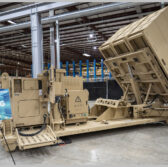The rapid growth of artificial intelligence raises important questions across the defense sector, but one area of defense stands to gain from AI immediately: research and development.
That’s according to Simon Porter, vice president of research futures with technology company Digital Science, who says “responsible AI” tools that help make R&D quicker and easier are already available.
Porter says he foresees a near future in which AI will become ubiquitous in R&D.
“For defense, just as in all areas of society, there is significant potential to narrow the gap between research and actionable insights,” Porter remarked.
It’s Not About AI
“The world is moving towards AI not just as a standalone tool or product but as a fully integrated part of services, products and experiences,” Porter asserted.
“For example, Apple has recently announced that AI — or ‘Apple Intelligence’ — will be front and center across its entire suite of products and services. Apple’s strategy is not to make AI a product in itself but an enhancement that makes its products work better, and does so seamlessly,” he continued.
Apple has now partnered with OpenAI (home of ChatGPT) to improve its Siri voice interface, so that if Siri receives an input from a user it cannot help with, ChatGPT can deliver a more appropriate response.
“The U.S. defense sector is always evolving. As AI adoption becomes more prevalent, the integration of comprehensive research tools will become increasingly crucial across all areas of research, particularly in those areas that seek to command or maintain strategic advantage,” Porter said.
On the research side, Dimensions from Digital Science provides a robust suite of tools designed to streamline and enhance research processes across various domains. For defense companies and research organizations, this means access to a vast repository of scientific publications, patents, clinical trials and funding data, all integrated into a single platform.
“The ability to navigate this wealth of information efficiently is critical for researchers tasked with developing new technologies, improving existing systems, and understanding emerging threats,” Porter said.
“Like Apple, Digital Science has been working to embed AI into tools like Dimensions where the user experience is enhanced and optimized by AI, but not driven by it.”
A Compelling Case for Defense R&D
“Technologically advanced products such as Dimensions can be transformative, offering unparalleled access to research insights and data analytics. This is particularly important for areas like defense, which must evolve rapidly in response to a dynamically changing environment,” Porter said.
“By integrating Dimensions into their research processes, defense firms can enhance their technological advancements, support strategic decision-making, and maintain operational efficiency. As the U.S. defense sector continues to evolve, the adoption of platforms like Dimensions will be instrumental in driving innovation and ensuring national security,” he added.
Use cases include:
1. R&D optimization: Defense companies invest heavily in R&D to create advanced weaponry, cybersecurity systems and communication networks. Dimensions allows researchers to track the latest scientific advancements and technological trends by providing real-time access to millions of research articles and patents. For instance, a defense contractor developing next-generation drones can use Dimensions to identify breakthroughs in drone technology, materials science and AI algorithms, ensuring their projects are built on the latest innovations.
2. Competitive intelligence: Understanding the activities and capabilities of potential adversaries is vital for national security. Dimensions offers detailed analytics on global research trends and funding patterns, helping defense companies anticipate technological developments in other countries. By analyzing international patents and research collaborations, defense firms can gain insights into emerging technologies that may pose a threat or present opportunities for collaboration.
3. Collaboration and partnerships: Innovation in the defense sector increasingly relies on collaboration between academia, industry and government in pursuit of technological advancement. Dimensions facilitates these partnerships by mapping out the research ecosystem, highlighting key players, and identifying potential collaborators based on their research outputs and expertise.
4. Monitoring technological progress: Keeping track of technological progress is essential for maintaining a competitive edge. Dimensions offers tools for monitoring citations, tracking influential publications, and analyzing the impact of research. Defense companies can use these features to gauge the significance of new technologies and their adoption rates within the industry. This insight helps prioritize research investments and strategic initiatives, ensuring that resources are allocated to the most promising areas.
Find out more about Dimensions or contact the Dimensions team for a demo.





